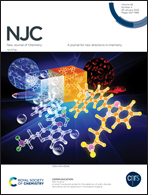A selective fluorescent probe based on citrate doped polypyrrole for dual determination of VO2+/Fe3+ in biological samples†
Abstract
Vanadyl sulfate has been widely utilized in the medical field due to its physiological performance like muscle improvement, insulin-mimetic activity, and antitumor properties. Herein, we have developed a facile and highly selective fluorescence technique for dual detection of VO2+ and Fe3+ in aqueous and biological media using citrate doped polypyrrole as a highly bright fluorescent sensor. The fluorescent PPy–Cit sensor showed time-dependent responses to VO2+ and Fe3+ ions. The emission of PPy–Cit was quenched very quickly in response to VO2+, while Fe3+ quenched the probe after five minutes. This probe was then applied for VO2+ and Fe3+ determination in serum samples and vanadyl sulfate tablets. The response of the probe was linear over the concentration from 1 to 100 μM and 5 to 80 μM with a detection limit of 340 and 590 nM for VO2+ and Fe3+ respectively under optimum experimental conditions. The results obtained by using the PPy–Cit probe agreed well with ICP-EOS data. The fluorescent probe provides a promising strategy to rapidly screen VO2+ and Fe3+ in biological fluids for medical and pharmaceutical applications.



 Please wait while we load your content...
Please wait while we load your content...